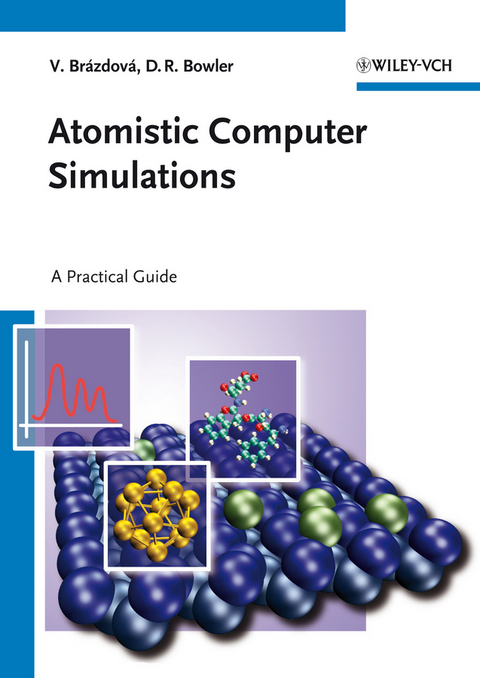Atomistic Computer Simulations
Wiley-VCH (Verlag)
978-3-527-41069-9 (ISBN)
This introductory "how to" title enables readers to understand, plan, run, and analyze their own independent atomistic simulations, and decide which method to use and which questions to ask in their research project.
This introductory "how to" title enables readers to understand, plan, run, and analyze their own independent atomistic simulations, and decide which method to use and which questions to ask in their research project. It is written in a clear and precise language, focusing on a thorough understanding of the concepts behind the equations and how these are used in the simulations. As a result, readers will learn how to design the computational model and which parameters of the simulations are essential, as well as being able to assess whether the results are correct, find and correct errors, and extract the relevant information from the results. Finally, they will know which information needs to be included in their publications.This book includes checklists for planning projects, analyzing output files, and for troubleshooting, as well as pseudo keywords and case studies.The authors provide an accompanying blog for the book with worked examples, and additional material and references: http://www.atomisticsimulations.org/.
Dr. Veronika Brázdová obtained her PhD from Humboldt University Berlin in 2005 with Professor J. Sauer. She is currently a Postdoctoral Research Fellow at the London Centre for Nanotechnology, University College London. Her research is focused on computational simulations of solid state surfaces and interfaces, using mainly density functional theory. She has been collaborating closely with experimental groups. She is also an experienced programmer, particularly in Fortran 90 and the Message Passing Interface. She has supervised many undergraduate students taking their first steps in computational physics. Dr. David R. Bowler received his D.Phil. from Oxford University in 1997. He has been a Reader in Physics at UCL since 2005, and held a Royal Society University Research Fellowship from 2002-2010. He is a PI in the London Centre for Nanotechnology and the London-wide Thomas Young Centre. He has driven the development of the massively-parallel linear scaling density functional theory code, Conquest, and collaborates extensively with experimental groups on the growth and properties of nanostructures on semiconductor surfaces.
Part One: The World at the Atomic Scale
1 Atoms, Molecules and Crystals
2 Bonding
3 Chemical Reactions
4 What Exactly is Calculated?
Part Two: Introducing Equations to Describe the System
5 Total Energy Minimization
6 Molecular Dynamics and Monte Carlo
Part Three: Describing Interactions Between Atoms
7 Calculating Energies and Forces
8 Electronic Structure Methods
9 Density Functional Theory in Detail
Part Four: Setting Up and Running the Calculation
10 Planning a Project
11 Coordinates and Simulation Cells
12 The Nuts and Bolts
13 Tests
Part Five: Analyzing Results
14 Looking at Output Files
15 What to do with All the Numbers
16 Visualization
17 Electronic Structure Analysis
18 Comparison to Experiment
"What a gem! This is a truly outstandingly useful book for anyone working in (or supervising students in) projects based around atomistic computer simulations . . . This book is a joy to read and will be of interest to specialists but also to anyone with a general interest in physics and indeed the history of science." ( Contemporary Physics , 11 April 2014)
| Erscheint lt. Verlag | 13.3.2013 |
|---|---|
| Verlagsort | Weinheim |
| Sprache | englisch |
| Maße | 170 x 240 mm |
| Gewicht | 775 g |
| Themenwelt | Mathematik / Informatik ► Informatik ► Theorie / Studium |
| Naturwissenschaften ► Physik / Astronomie ► Atom- / Kern- / Molekularphysik | |
| Schlagworte | atomic and molecular physics • Atomphysik • Atom- u. Molekülphysik • catalysis • Ceramics • Chemie • Chemistry • Computer Science • Condensed Matter • Dünne Schichten, Oberflächen u. Grenzflächen • Electrical & Electronics Engineering • Electrical & Electronics Engineering • Electronic materials • Elektronische Materialien • Elektrotechnik u. Elektronik • Festkörperphysik • Halbleiterphysik • Informatik • Katalyse • keramische Werkstoffe • Kondensierte Materie • Manipulation of Nanosystems • Manipulation von Nanosystemen • Materials Science • Materialwissenschaften • Mathematical & Computational Physics • Mathematical & Computational Physics • Mathematical Modeling • Mathematics • Mathematik • Mathematische Modellierung • Mathematische Physik • Modell (Math.) • Nanochemie • nanochemistry • Nanomaterialien • nanomaterials • Nanophysics • Nanophysik • Nanotechnologie • nanotechnology • Physical Chemistry • Physics • Physik • Physikalische Chemie • Quantenphysik u. Feldtheorie • Quantum Physics & Field Theory • Quantum Physics & Field Theory • Semiconductor physics • Solid state physics • Thin Films, Surfaces & Interfaces • Thin Films, Surfaces & Interfaces |
| ISBN-10 | 3-527-41069-4 / 3527410694 |
| ISBN-13 | 978-3-527-41069-9 / 9783527410699 |
| Zustand | Neuware |
| Haben Sie eine Frage zum Produkt? |
aus dem Bereich





